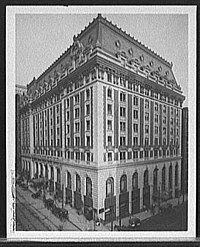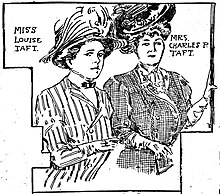David Sinton
David Sinton | |
|---|---|
 | |
| Born | June 26, 1808 |
| Died | August 31, 1900 (aged 92) |
| Occupation | Industrialist |
| Spouse |
Jane Ellison
(died 1853) |
| Children | Anna Sinton Taft |
| Parent(s) | John Sinton Mary McDonnell |
| Relatives | Charles Phelps Taft (son-in-law) |
David Sinton (26 June 1808 – 31 August 1900) was an Irish-born American pig-iron industrialist, born in County Armagh, Ireland, who became one of the wealthiest people in America.
Early life[edit]
Sinton was the son of linen manufacturer John Sinton, of Unshinagh, a Quaker (he was a cousin of Irish Quaker industrialist brothers Thomas Sinton and John Sinton), and Mary McDonnell.[1]
In 1811, the family came to America, from Ireland, and settled at Pittsburgh when he was three years of age. Sinton had one brother (Dr. William Sinton, a physician) and two sisters (Isabella Eliza - never left Ireland and Sarah, married John Sparks - a banker).[1][2]
Career[edit]


In the 1830s, Sinton was a manager of the ironworks at Hanging Rock, Ohio. In 1846, he managed to become the owner and made his headquarters in Cincinnati.[3]
A man of "irregular education",[4] his business interests centered on the manufacture of iron; the location of his furnaces was Lawrence County, Ohio.[5] Much of his fortune was made by stockpiling pig iron, waiting for the American Civil War and the selling that iron on at inflated prices.[4] He eventually acquired the majority of stock in the Eureka Company and, at the time that Oxmoor merged with the DeBardeleben Coal and Iron Company, he owned most of Oxmoor.[6]
He was described as "a large, strong person with strong common sense, and therefore moves solely on the solid foundation of facts." His residence, at Cincinnati, was the old Longworth mansion on Pike Street, built by Martin Baum early in the 19th century. Mr. Sinton's only surviving child, Annie, was the wife of Charles Phelps Taft, editor of the Times-Star[5] and brother of William Howard Taft; Sinton money was said to have financed the presidential bid.[4]
Personal life[edit]
Sinton married Jane Ellison (1826–1853), a daughter of John Ellison (1779–1829), at Union Landing, Ohio. They had two children:
- Edward Sinton (1848-1869)[7]

- Anna Sinton (1850-1931), who married U.S. Representative Charles Phelps Taft (1843–1929), the older brother of William Howard Taft, the 27th President of the United States and 10th Chief Justice of the United States.[1]
Sinton died on August 31, 1900, in Cincinnati, Ohio.[8] Upon his death, he left $20,000,000 (the 2011 equivalent of this is about $500,000,000) to his daughter, he was Ohio's richest man at the time.[8] His home is now the Taft Museum of Art.[9][10]
Descendants[edit]
Through his daughter Anna, he was the grandfather of Jane Taft Ingalls (1874–1962), David Sinton Taft (1876–1891), Anna Louise Taft Semple (1879–1961), and Charles Howard Taft (1885–1931). He was the great-grandfather of First World War flying ace David Sinton Ingalls.[11]
Legacy[edit]
During his lifetime, Sinton was philanthropic in his donations to the arts and the Presbyterian church, yet his own father's grave was not marked with a headstone; "but David Sinton is wiser in his generation than they who seek to stab his character in such a paragraph [as erecting an ornate sepulcher]. He is one of God's noblemen."[12]
The town of Sinton, Texas, is named in his honor (given that he was the majority stock holder in Coleman-Fulton Pasture Company[13]).
References[edit]
- ^ a b c Evans, Nelson Wiley; Stivers, Emmons B. (1900). A History of Adams County, Ohio: From Its Earliest Settlement to the Present Time, Including Character Sketches of the Prominent Persons Identified with the First Century of the Country's Growth ... E B. Stivers. p. 621. Retrieved 15 December 2017.
- ^ History of Cincinnati and Hamilton County, Ohio. S. B. Nelson & Company. 1894. pp. 469–470. Retrieved 15 December 2017.
- ^ Association, American Iron and Steel (1908). The Bulletin of the American Iron and Steel Association. James M. Swank. p. 69. Retrieved 15 December 2017.
- ^ a b c Hess, Stephen, America's Political Dynasties, P. 306
- ^ a b Historical Collections of Ohio: Pages 843-847
- ^ Armes, Ethel (1910). The Story of Coal and Iron in Alabama. Pub. under auspices of the Chamber of Commerce. p. 261. Retrieved 15 December 2017.
- ^ Kingdom, Bob Sinton, Tandragee, Co. Armagh, Northern Ireland, United. "Sinton Family Trees - Details of Edward M. Sinton, son of David Sinton and Jane Ellison, Born 1848, Died 1869". www.sinton-family-trees.uk. Retrieved 15 December 2017.
{{cite web}}: CS1 maint: multiple names: authors list (link) - ^ a b "OHIO'S RICHEST MAN DEAD.; David Sinton Leaves $20,000,000 to His Daughter" (PDF). The New York Times. September 1, 1900. Retrieved 15 December 2017.
- ^ "Taft Museum of Art". Archived from the original on 2008-02-08. Retrieved 2008-02-12.
- ^ Rogers, Gregory Parker (2013). Fountain Square and the Genius of Water: The Heart of Cincinnati. Arcadia Publishing. p. 17. ISBN 9781614239598. Retrieved 15 December 2017.
- ^ "Milestones, Feb. 9, 1931". Time. 9 February 1931. Archived from the original on October 22, 2012. Retrieved 15 December 2017.
- ^ "The Lawrence County Register". Archived from the original on 2007-11-28. Retrieved 2008-02-13.
- ^ "Relocate America; Sinton, Texas". Archived from the original on 2011-07-15. Retrieved 2008-02-13.
